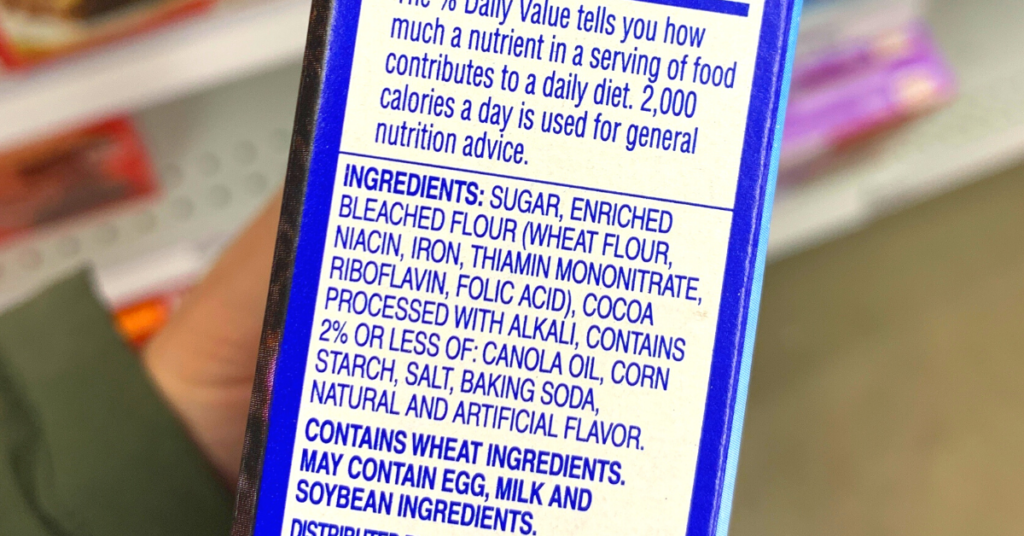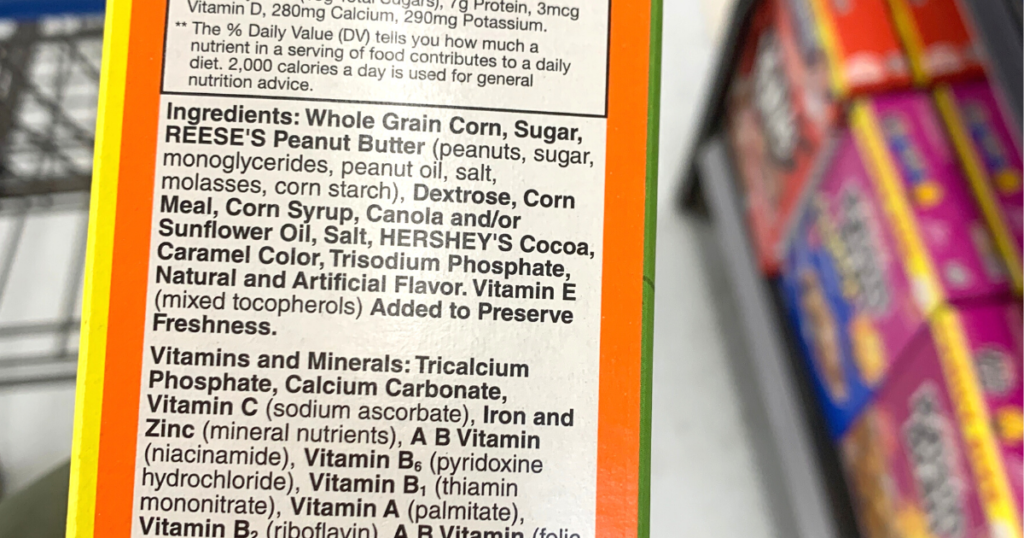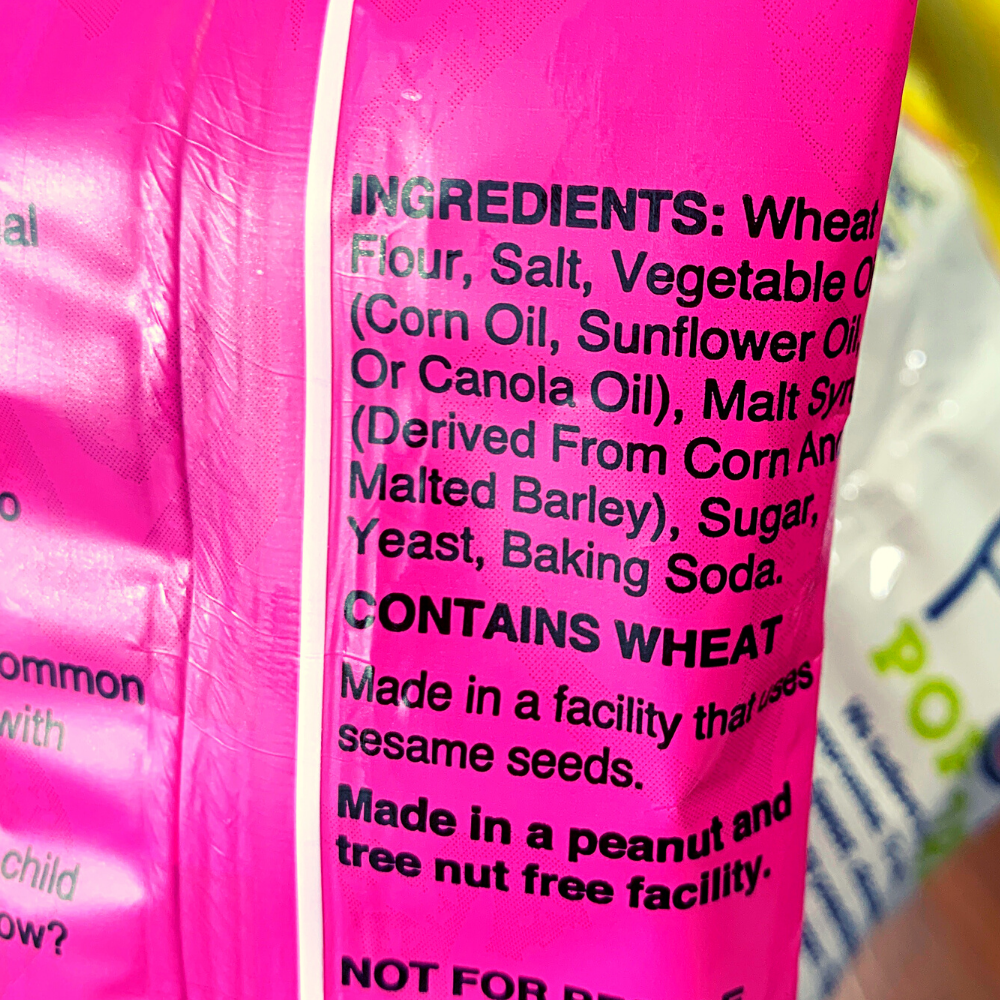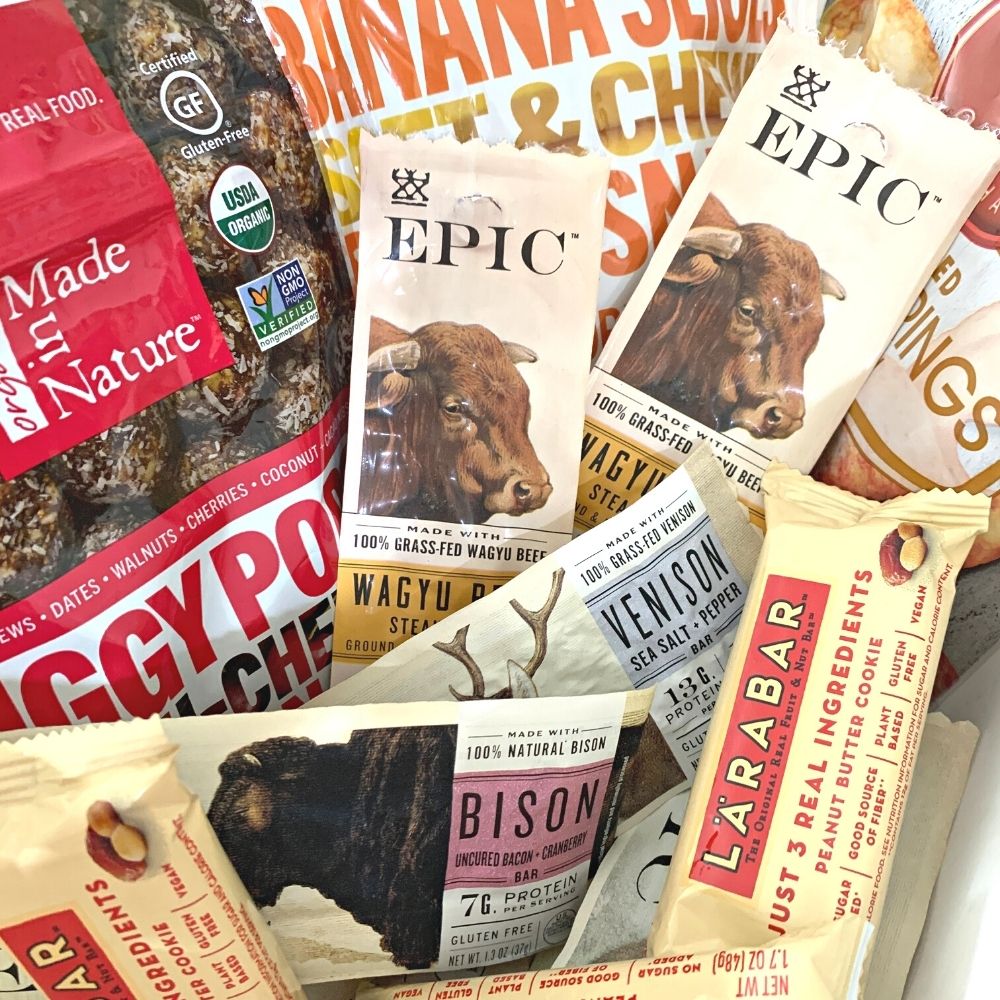Understanding Food Labels

In this post, we’re talking about food labels. Not the part that has you reading portion sizes or counting calories. I’m talking about the part that actually shows what’s in the food when you’re buying a packaged or processed item. Portion size and counting calories are fine if your main goal is to lose weight. But for the overall health of your family, you need to know what’s in your food. You can consume as few or as many calories as you want, but the calories don’t tell you how nutritious a food is.
After reading this post you’ll be able to grocery shop with confidence and not fall victim to the marketing ploys of “heart healthy” and “all natural” plastered all over packages. And be sure to check out my post all about easy steps to start eating healthier for the whole family for other great tips!
Start and Stop at the Ingredients List
To be honest, usually the first and last place I look at on a food label is at the ingredients list. Short and sweet, this blog post is done! Just kidding. If only it was that simple.
The ingredients list is where you can quickly skim to see if there’s anything in the product that you should be avoiding, which there usually is if there’s more than three or four ingredients! It’s also the best place to check if food allergies are a concern. Allergies were the reason we got into the habit of checking labels and looking into what the ingredients actually are.
By law, manufacturers have to list the top 8 allergens on their food labels (they’re adding sesame as number 9, but the labeling won’t go into effect until 2023.) But that’s not always helpful to those that have allergies to foods other than the top 8 (or 9) food allergies. That’s why it’s important to read all the ingredients listed.
The ingredients label lists the ingredients in order by weight. So the first thing on the list is the biggest portion of what’s in that product. But don’t skip out on reading the rest of the ingredients! Because this is where it can get tricky.
Many manufacturers will use different names for the same ingredient. Let’s use sugar for an example. You might see sugar listed as the second ingredient, then further down the list you’ll see dextrose, then corn syrup, then fructose and/or maltodextrin. All different names for refined sugars that your body has a hard time processing. (Check out this article that lists the 61 different names of sugar!) But when you total up the actual weight of all the different kinds of sugar listed, their amount might just actually be more than the first ingredient listed! They just don’t have to be listed first because, technically, they’re different ingredients of differing weights. Still sugars, but all different kinds.
This is the loophole, along with our lack of knowledge on the many names of one single ingredient, that companies use to sell their product to consumers who may be turned off to having something like sugar as the main ingredient in the product. Clever marketing.

Food Label or Chemistry List?
The other thing you’ll see in the ingredients list is a lot of long, scientific sounding names that the majority of us can’t even pronounce. I’m not saying all of them are bad, as some are just the scientific name for the ingredient. But the fact remains that the vast majority of them are actually man-made additives and preservatives.
Why should that concern us as moms?
Because more and more studies are linking these processed ingredients to issues with hormones, growth, and development in our kiddos. And haven’t we seen a huge increase in chronic diseases and conditions since the development of processed foods? Seriously, you can google that one and it’ll bring up a plethora of info on that.
But because of the gaps in the FDA’s regulatory process, we’re not likely to see any reduction in the additives and preservatives on the ingredients list any time soon.
Even in 2018, the American Academy of Pediatrics stated the FDA’s regulation of these additives is seriously lacking. Here’s a quote from the article:
“Concern regarding food additives has increased in the past 2 decades, in part because of studies in which authors document endocrine disruption and other adverse health effects. In some cases, exposure to these chemicals is disproportionate among minority and low-income populations. Regulation and oversight of many food additives is inadequate because of several key problems in the Federal Food, Drug, and Cosmetic Act. Current requirements for a “generally recognized as safe” (GRAS) designation are insufficient to ensure the safety of food additives and do not contain sufficient protections against conflict of interest. Additionally, the FDA does not have adequate authority to acquire data on chemicals on the market or reassess their safety for human health. These are critical weaknesses in the current regulatory system for food additives. Data about health effects of food additives on infants and children are limited or missing; however, in general, infants and children are more vulnerable to chemical exposures. Substantial improvements to the food additives regulatory system are urgently needed, including greatly strengthening or replacing the “generally recognized as safe” (GRAS) determination process, updating the scientific foundation of the FDA’s safety assessment program, retesting all previously approved chemicals, and labeling direct additives with limited or no toxicity data.”
From the American Academy of Pediatrics – Volume 142, Issue 2
August 2018
And we’re still waiting for improvements to the system to be implemented. I seriously encourage you to read the full article here.
So when you look at that ingredients list and it looks more like an excerpt from a chemistry book, it’s a safe bet it’s been highly processed and should be avoided. Best stick with labels that have only 3-4 ingredients listed when possible or are ingredients that you actually know what they are.
A List of Ingredients to Avoid
So you might be thinking, okay, but what exactly should I be avoiding as far as the ingredients go?

Well, that’s going to depend on your level of comfort with what you eat and feed your kids. Some people don’t think twice about reading the ingredients list on what they buy. Some will never look into what the ingredients listed actually are or how they can actually be harming our health.
But I’m guessing since you’re here and reading this, that’s not you. So can I just say, good for you! Taking control of your health and your families health starts right here and you should be proud of yourself for taking that step!
The fact remains, though, that unless you’re hardcore about avoiding ALL processed ingredients, most of us are going to consume some processed foods and ingredients. But when we know better, we can do better, right?!
Here’s a list for a good start on what ingredients you should learn to avoid in your foods:
- Hydrogenated oils – this includes canola oil, vegetable oil, corn oil, margarine, shortening, and anything that has “trans fat” listed or says “partially or fully hydrogenated”. It’s in a lot of fried and baked foods, as well as boxed items.
- Sodium nitrates/nitrites – be checking those deli meats, hotdogs, and bacon.
- Artificial sweeteners – as the name implies, they’re fake, which means our body doesn’t process them well. Watch for names like sucralose, aspartame and saccharin. They spike blood sugar levels more than regular sugar.
- Sugar – as mentioned before, sugar comes in many names. The ones to avoid are high fructose corn syrup, corn syrup, dextrose, maltodextrin, dextrin, glucose, malt, rice syrup, and many more.
- Artificial flavors and colors – The research on these is mixed, though, many people do find they’re sensitive to them. But the fact remains that they aren’t made from food products and aren’t meant to be in the body. These are your colors list of red, yellow 1, 2, and 3, blue, and caramel.
- Enriched wheat or bleached flours – This flour has been highly processed with multiple ingredients added back into it that make it hard for your body to process.
- Potassium benzoate or sodium benzoate – may be harmless by themselves, but when paired with Vitamin C, heat and light, it can form benzene, which is a carcinogen. You’ll see this one in a lot of soft drinks and juices.
- BHA and BHT – synthetic preservatives you’ll see in a multitude of foods. BHA has been labeled as reasonably anticipated to be a human carcinogen, while BHT is suggested to avoid when possible.
I could go on with other ingredients to be aware of and avoid, but if you’re just starting out, this is a good place to start.
Ingredients that You Want on Food Labels
So now you know some ingredients to avoid, but what about ones that are actually pretty okay for a packaged item? Of course, I’m going to say whole foods, real foods are always better. Make your food from scratch and you’ll know the ingredients in it. But that’s not reality for most of us busy moms and that’s okay! We can be selective about the packaged foods we buy to ensure they have the healthier ingredients in them.
So when checking the labels, if you see the ingredients listed below on your product, then you’re on the right track.
- Oils – Avocado oil, coconut oil, flaxseed oil and olive oil are all great choices. Butter, ghee, tallow and lard are also great as they have their own unique health benefits. Just be sure to check any oil’s smoke point if frying with so as not to destroy the actual health benefits they provide.
- Grains/Flours – The best grains or flours to look for are going to be sprouted, soaked, fermented, or slow-rise sourdough, as they’re easier for your body to digest. The label should specify what they are and should have basic, minimal ingredients.
- Sugar – Sticking with natural sweeteners like honey or maple syrup are a healthier choice, but going with some of the less processed sugars like coconut sugar, date sugar, or monk fruit are good options as well. The more sugar you can limit, the more your body (and your kid’s body) will thank you!
It’s easy to get overwhelmed by food labels, but if you know the right spot to look, it’s actually a lot easier than you think. And when you know not only what to start avoiding, but what to start looking for, then you’re well on your way to a healthier you and a healthier family. Like I said before, the ingredients list is going to be the best place to start, and stop with, when it comes to knowing what exactly is in your packaged food.

Looking for a few ideas on some healthier packaged snacks for the kiddos? Check out some of our favorites right here.
I’d love to hear some of your favorite healthy packaged food items in the comments below. The more ideas we share, the easier we make it for each other as mamas trying to live a healthier life!

